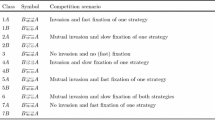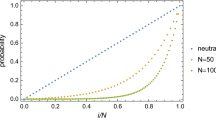Abstract
Evolutionary game theory is a mathematical approach to studying how social behaviors evolve. In many recent works, evolutionary competition between strategies is modeled as a stochastic process in a finite population. In this context, two limits are both mathematically convenient and biologically relevant: weak selection and large population size. These limits can be combined in different ways, leading to potentially different results. We consider two orderings: the \(wN\) limit, in which weak selection is applied before the large population limit, and the \(Nw\) limit, in which the order is reversed. Formal mathematical definitions of the \(Nw\) and \(wN\) limits are provided. Applying these definitions to the Moran process of evolutionary game theory, we obtain asymptotic expressions for fixation probability and conditions for success in these limits. We find that the asymptotic expressions for fixation probability, and the conditions for a strategy to be favored over a neutral mutation, are different in the \(Nw\) and \(wN\) limits. However, the ordering of limits does not affect the conditions for one strategy to be favored over another.



Similar content being viewed by others
References
Abramowitz M, Stegun IA (1964) Handbook of mathematical functions: with formulas, graphs, and mathematical tables, vol 55. Courier Corporation, New York
Allen B, Nowak MA (2014) Games on graphs. EMS Surv Math Sci 1(1):113–151
Antal T, Scheuring I (2006) Fixation of strategies for an evolutionary game in finite populations. Bull Math Biol 68(8):1923–1944
Bladon AJ, Galla T, McKane AJ (2010) Evolutionary dynamics, intrinsic noise, and cycles of cooperation. Phys Rev E 81(6):066122
Blume LE (1993) The statistical mechanics of strategic interaction. Games and economic behavior 5(3):387–424
Bomze I, Pawlowitsch C (2008) One-third rules with equality: second-order evolutionary stability conditions in finite populations. J Theor Biol 254(3):616–620
Broom M, Rychtár J (2013) Game-theoretical models in biology. Chapman & Hall/CRC, Boca Raton
Chen YT (2013) Sharp benefit-to-cost rules for the evolution of cooperation on regular graphs. Ann Appl Probab 23(2):637–664
Fisher RA (1930) The genetical theory of natural selection. Oxford University Press, Oxford
Haldane JBS (1927) A mathematical theory of natural and artificial selection, part V: selection and mutation. Math Proc Camb Philos Soc 23:838–844
Harsanyi JC, Selten R et al (1988) A general theory of equilibrium selection in games, vol 1. MIT Press Books, Cambridge
Helbing D (1996) A stochastic behavioral model and a ‘microscopic’ foundation of evolutionary game theory. Theor Decis 20(2):149–179
Hofbauer J, Sigmund K (1998) Evolutionary games and replicator dynamics. Cambridge University Press, Cambridge
Ibsen-Jensen R, Chatterjee K, Nowak MA (2015) Computational complexity of ecological and evolutionary spatial dynamics. Proc Nat Acad Sci 112(51):15,636–15,641
Imhof LA, Nowak MA (2006) Evolutionary game dynamics in a Wright–Fisher process. J Math Biol 52(5):667–681
Jeong HC, Oh SY, Allen B, Nowak MA (2014) Optional games on cycles and complete graphs. J Theor Biol 356:98–112
Kimura M (1964) Diffusion models in population genetics. J Appl Probab 1(2):177–232
Ladret V, Lessard S (2008) Evolutionary game dynamics in a finite asymmetric two-deme population and emergence of cooperation. J Theor Biol 255(1):137–151
Lessard S, Ladret V (2007) The probability of fixation of a single mutant in an exchangeable selection model. J Math Biol 54(5):721–744
Lessard S (2011) On the robustness of the extension of the one-third law of evolution to the multi-player game. Dyn Games Appl 1(3):408–418
Moran PAP (1958) Random processes in genetics. Math Proc Camb Philos Soc 54(01):60–71
Nowak MA, May RM (1992) Evolutionary games and spatial chaos. Nature 359(6398):826–829
Nowak MA, Sasaki A, Taylor C, Fudenberg D (2004) Emergence of cooperation and evolutionary stability in finite populations. Nature 428(6983):646–650
Nowak MA, Tarnita CE, Antal T (2010) Evolutionary dynamics in structured populations. Philos Trans R Soc B Biol Sci 365(1537):19–30
Ohtsuki H, Nowak MA (2006) Evolutionary games on cycles. Proc R Soc B Biol Sci 273(1598):2249–2256. doi:10.1098/rspb.2006.3576
Ohtsuki H, Hauert C, Lieberman E, Nowak MA (2006) A simple rule for the evolution of cooperation on graphs and social networks. Nature 441:502–505
Ohtsuki H, Bordalo P, Nowak MA (2007) The one-third law of evolutionary dynamics. J Theor Biol 249(2):289–295
Saakian DB, Hu C-K (2016) Solution of classical evolutionary models in the limit when the diffusion approximation breaks down. Phys Rev E 94(4):042422
Smith JM (1982) Evolution and the theory of games. Cambridge University Press, Cambridge
Smith JM, Price GR (1973) The logic of animal conflict. Nature 246(5427):15–18
Szabó G, Fáth G (2007) Evolutionary games on graphs. Phys Rep 446(4–6):97–216
Tarnita CE, Ohtsuki H, Antal T, Fu F, Nowak MA (2009) Strategy selection in structured populations. J Theor Biol 259(3):570–581. doi:10.1016/j.jtbi.2009.03.035
Taylor C, Fudenberg D, Sasaki A, Nowak M (2004) Evolutionary game dynamics in finite populations. Bull Math Biol 66:1621–1644
Taylor PD, Day T, Wild G (2007) Evolution of cooperation in a finite homogeneous graph. Nature 447(7143):469–472
Thomson BS, Bruckner JB, Bruckner AM (2001) Elementary real analysis. Prentice Hall Inc, Upper Saddle River
Traulsen A, Claussen JC, Hauert C (2005) Coevolutionary dynamics: from finite to infinite populations. Phys Rev Lett 95(23):238701
Traulsen A, Nowak MA, Pacheco JM (2006a) Stochastic dynamics of invasion and fixation. Phys Rev E 74(1):011909
Traulsen A, Pacheco JM, Imhof LA (2006b) Stochasticity and evolutionary stability. Phys Rev E 74(2):021905
Traulsen A, Pacheco JM, Nowak MA (2007) Pairwise comparison and selection temperature in evolutionary game dynamics. J Theor Biol 246(3):522–529
Weibull JW (1997) Evolutionary game theory. MIT press, Cambridge
Wright S (1931) Evolution in mendelian populations. Genetics 16(2):97–159
Wu B, Altrock PM, Wang L, Traulsen A (2010) Universality of weak selection. Phys Rev E 82(4):046106
Wu B, García J, Hauert C, Traulsen A (2013) Extrapolating weak selection in evolutionary games. PLoS Comput Biol 9(12):e1003381
Wu B, Bauer B, Galla T, Traulsen A (2015) Fitness-based models and pairwise comparison models of evolutionary games are typically different–even in unstructured populations. New J Phys 17(2):023043
Zheng X, Cressman R, Tao Y (2011) The diffusion approximation of stochastic evolutionary game dynamics: mean effective fixation time and the significance of the one-third law. Dyn Games Appl 1(3):462–477
Author information
Authors and Affiliations
Corresponding author
Rights and permissions
About this article
Cite this article
Sample, C., Allen, B. The limits of weak selection and large population size in evolutionary game theory. J. Math. Biol. 75, 1285–1317 (2017). https://doi.org/10.1007/s00285-017-1119-4
Received:
Revised:
Published:
Issue Date:
DOI: https://doi.org/10.1007/s00285-017-1119-4




